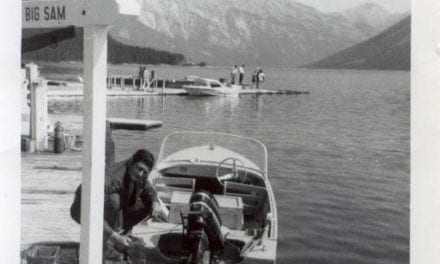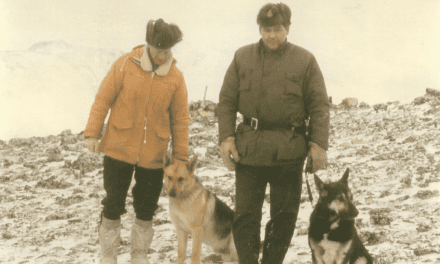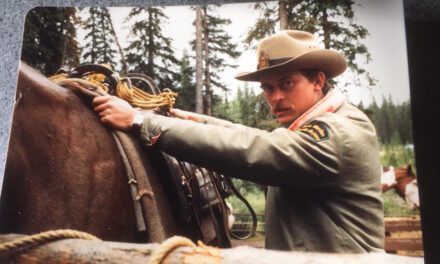SH: Mary was doing that as well wasn’t she?
Dave: Yes, Mary was the Warden Service Communications Specialist and worked closely with Heather. Mary’s focus in Banff was human/wildlife conflict, public safety, fire/vegetation and backcountry. She was part of a team of communication specialists working at the mountain park level on shared issues. So, it was all the mountain parks integrated and working together to save money and become much more efficient.
SH: Very cohesive.
Dave: Very cohesive group and there were really excellent working relationships. Other notables that I got to work with were people like Don Mickle and Jim Murphy, Glen Peers, Scott Ward and Mike Gibeau. Mike was a carnivore specialist and had done the East Slopes Grizzly Bear Project and he was really great to work with as well.
I can’t say enough about Cliff. Cliff was brilliant to work with. He was innovative, could write quality environmental assessments quickly, coordinate the other resource management specialists and had a broad base of contacts in Parks Canada, the Town and the provinces of Alberta and B.C. He knew the park so well that he could make operational all the science and research that was being undertaken very quickly. Not many people could undertake complex ecological work and put it on the ground like Cliff could.
Mary and I commuted to work with Cliff and Tim Auger. Cliff was working on his PhD at the time. He’d be up at four o’clock in the morning and he would pour himself into the car at 7:30am, after three coffees and just start talking …. mid problem solving. By the time we got to Banff we’d figured out what Cliff was talking about. They were great rides into work with Cliff and the same thing would happen with Tim. Something would happen in the park, or some other park and Tim would start recounting similar issues that he was involved with in our park, or he would point to a climb on the route to work and describe it, hand hold by hand hold. It was just the most interesting commute you can imagine. These two guys were pretty special.
With Charlie Pacas, we pushed the envelope for the sewage treatment plant, setting probably one of the highest standards, certainly the highest standard in the mountain national parks and probably one of the highest standards for sewage treatment in Canada at the time. Not an easy sale, but it worked because of the inter-disciplinary nature of our organization at the time with the Ecosystem Secretariat.
Moving science into decision making was I think one of the most exciting things that we could have ever done. I can’t say enough about that. Although we used the best science available, there were knowledge gaps and we were able to adapt our implementation strategies (adaptive management) as needed to apply new information.
SH: Yes, and you were super fortunate then because we had really great Superintendents then like Jillian Roulet and Charlie Zinkan who really bought into that concept …. and Bill Fisher. That’s what I recall of that period.
Dave: Yes, that model worked really well. But, we knew when the management plan was approved, that we might have five years to solve some of the big ecological issues in the park, one being elk concentrating in the Banff townsite area of the Bow Valley and using the town to avoid predators. Glen Peers had a very busy job dealing with human- wildlife conflict around Town.
The elk management strategy was developed with a very broad-based advisory committee. We received excellent advice, and we were able to move the idea of culling the elk herd and relocating some of the elk herd to other parts of the province without any conflicts. It was a pretty interesting time. Dave Norcross built “Elkatraz” to isolate and treat elk for parasites and liver fluke before moving them. Cougars looked at them longingly from outside the fences. To get the elk to participate in the ecosystem, the wildlife underpasses in the townsite area were blocked with permeable fences that stopped elk from coming into town, but enabled passage of predators and other wildlife.
The President of the Bow Valley Naturalists at the time was Mike McIvor. He made outstanding contributions to the work of Parks Canada. Mike came to me after a couple of meetings and said, “I hear you’re censoring the wardens”. I said “Tell me about that.” He said “Well, apparently you have meetings ahead of time and you tell people what to say.” I said, “Mike it’s true that we do have meetings ahead of time and I think you’ll recall the first meeting we had when I had staff arguing with each other. They weren’t dealing with the committee; they’re arguing with each other. They are not putting out any kind of a consistent front. They hadn’t resolved their differences, so yes. I brought the group together before the meeting to sort out where the issues were that needed to be resolved, and we went to the advisory committee meetings with a unified approach. I had nothing to do with censoring at all. It was managing to coordinate the different thinking. Mike was challenging my integrity and from that day on Mike and I worked really well together.
Mike did come to me one other time when we wanted to do the Fairholme burn. We had to do quite a bit of mechanical logging in the area to build a fireguard in order to light the fire. Mike said, “We aren’t going to agree to this if there’s any chance that you won’t burn after you do the logging.”
I assured Mike that we would definitely burn, we are not doing this logging unless we are burning. So, I think with that, we had pretty strong credibility with the Bow Valley Naturalists, who up until those earlier days, prior to the Bow Valley Study really were a thorn for Parks Canada, trying to get us to do the right thing. I learned much later that Cliff had already smoothed the waters, but Mike wanted to hear it from a manager too. So, we were on very good terms at that point and forever actually, because mine was one of the very few retirement parties Mike went to. That was pretty cool. I was absolutely thrilled that he was there.
After the Ecosystem Secretariat dissipated and the functions were pulled back into the Warden Service, I went on to coordinate the mountain pine beetle program for all of the mountain national parks. Again, that was just a terrific inter-disciplinary exercise. We were working with the forest industry, and we were working with the province who were both very keen to see us deal with mountain pine beetles in the parks. Beetles were coming into the parks and were considered at that time as an invasive species and it fed right into our long-term ecological objective to reintroduce fire. We were able to burn out the mountain pine beetle and burn ahead of them so the spread of mountain pine beetle was significantly reduced.
SH: What year would that have been Dave?
Dave: The funding came from Canadian Forest Service in 2003 and from that year on, for the next five years, it was a five year program, and we managed to get another two years of funding beyond that. I think we actually set an example for the various programs through the Canadian Forestry Service, particularly from a business plan point of view.
Our business plans were excellent. One year I took a leave of absence to build an addition to our cabin. Tom Hurd acted for me as the project manager, and he did an outstanding job.
With that program we ended up receiving the Premier of Alberta’s silver Award of Excellence. The whole team got to meet Ralph Klein, the Premier at the time, and receive their little pin. It was definitely an awkward but a proud moment I think for the group.

Parks Canada staff in this photo include Jane Park, Jackie Syroteuk, Dave Dalman, Ian Pengelly, Tom Hurd, Cliff White and Darrel Zell.
SH: What was your final job?
Dave: The last thing I did was coordinate the Canadian Parks Council meeting in K Country working with Steve Donelon and again that was a good success. (Tape 15:25)
SH: What did you like about being associated with the Warden Service?
Dave: I think what the Warden Service showed me is that there was a grounded, talented and practical group of people that were involved in knowledge creation in the park and when the Ecosystem Secretariat was developed and communications people were put in place, one in the Warden Service and one in the Secretariat, that became an excellent way to move out that kind of knowledge development that was happening in the Warden Service. What I really liked about that model was it directly moved science-based decision making into the management of the parks.
SH: What didn’t you like about being part of, or associated with, the Warden Service?
Dave: I really liked working with all of the staff in the Warden Service, but over time they became a bit overly specialized and when that happened the generalist nature of some of the staff gradually disappeared and I think we lost a lot of character and valuable efficiency when that happened.
SH: What are some of the more memorable events of your career being associated with the Warden Service?
Dave: At a personal level the elk management strategy led to doing media interviews around the world. When we talked about bringing back wolves to a golf course, people wanted to know how that was going to work out with the golfers. And again, the mountain pine beetle program. That was an excellent broader program where we could work outside the park and achieve park objectives at the same time, and that was a tremendous opportunity. So was the Prince Albert Model Forest, an excellent model of inter-agency, interdisciplinary cooperation that enabled us to focus on ecological integrity, regionally. There was also a lot of transboundary and inter-agency cooperation with Alberta, British Columbia, municipalities, interest groups and industry.
When I was still at the hot springs we had a visit from a guy I got to know named Graham Worboys. Graham was Director of the New South Wales National Park System in Australia and a terrific guy. He was up here trying to sort through different approaches to ecosystem management and wildlife corridors and asked if I could show him around. I had a meeting in Radium one Friday and suggested that he ride with me to see some of Kootenay National Park.
So, at 7:00 am we piled into the truck and off to Radium we travelled. As we turned down Highway 93 South, right at the cattleguard I stopped the truck. There was a pack of grey wolves chasing elk down on the highway side of the fence. It was a magical moment. The big dominant male wolf walked in front of the truck within feet. Graham’s camera was clicking away. His eyes were the size of saucers. It was just a fantastic moment and experience for him, and for me too.
SH: Wow, that’s very cool.
Dave: Yes. Thanks to Cliff again, he knew and I knew that you can’t be an ecosystem manager without knowing the resource. Thanks to Cliff I got out quite often, and thanks to Jim Murphy and others … Dave Norcross, Barb Johnson, Diane Volkers, Julie Timmins, Helene Galt, Mike Gibeau.
Cliff and I got out several times but on one occasion we had moved from Stoney to Flints Park and over to Windy and it was a dark and stormy night. It was pouring rain and my boots were soaked. So I put them by the fire, had dinner and sacked out early. Cliff stayed up for another half hour or so to read, and then he went to bed. Windy Cabin has two bedrooms and a front room with a big picture window and a mirror on the inside wall.
About 2:00am in the morning there was this huge crash. Cliff is in the other bedroom and I was totally out of it. Like where am I? but then I got it figured out. I’m in Windy Cabin and Cliff said, “Dave is that you?”, because he thought I’d walked into the mirror, and it had fallen off the wall. I said “No it’s not me” so Cliff jumps up and closes his bedroom door, thinking there’s a bear in the house, and I’m thinking what am I going to do here, because my bedroom door is open too. He immediately said, “We got problems” and slammed his bedroom door. Then he looked out the window and saw this big bear running back down towards the tack shed. So, we knew the bear wasn’t in the house. We needed to close the shutters in case the bear returned. I grabbed a gas lantern and Cliff grabbed a weedwhacker. We jump into our gumboots and in our underwear and pouring rain, we walk around the front of the house to see if the bear is still there. Looking into the dark, we could see that the bear had smashed a window that was about six or seven feet off the ground, so this is a big bear. So, we closed the shutters, went around the house and made sure the bear wasn’t following us around. The bear wasn’t anywhere to be seen, so we closed the shutters on the house and decided we’d deal with this in the morning. I don’t know what Cliff was thinking; maybe the weedwhacker would start if we saw a bear, but it was pretty funny.
On radio call the next morning Bob Haney was in Scotch Camp and reported that a bear had got into the fishery shed. The fishery shed had fish nets and various equipment they were doing research with, and the bear had got into that and tore it up a bit. What we then figured out was the bear came over the pass to Windy the same night. At 2:00am in the morning, the bear smashed our window, and tried to get into the tack shed but couldn’t get in there. That bear then went down … I’m not sure if he actually went to Barrier but he ended up at Dormer. A fellow named Marv Miller was moving a couple of days ahead of us, and when he arrived at Dormer, saw that a bear had gotten into the tack shed and had a big feed of oats. He was a happy bear with a bellyache someplace. So Cliff and I then started to make door and window mats, you know with nails, for each of the cabins we were going to. We moved from Windy to Barrier, and Barrier to Dormer. That was a bit of a rogue bear, and that bear ended up being shot two or three weeks later in the province. The bear was on a real tear and he was a big bear too. So that was sad. (Tape 10:07)

Dave Norcross, Barb Johnson, Dave Dalman & Dave Oickle heading out on patrol from the Ya Ha Tinda Ranch, October 1st, 2002. Photo by Marie Nylund.
SH: So your wife Mary asked me to ask you about a story in Point Pelee with a helicopter?
Dave: No, it was a fixed wing plane, it was a Cessna. I rented Cessnas periodically for aerial photography as seasons developed in the park to show different things. We were using infra-red film, water penetration film and various color and black and white films, to show different uses of aerial photography for resource management. I rented planes in Windsor which was the closest air base, to fly to Point Pelee. One day in the middle of the summer, we were flying at 4000 feet, and this was all calculated so that we’d get the proper scales for photography. It was one of the very first times I’d flown with the door on the plane; most of the time I flew without the door so that I could get good vertical imagery. I had the window opened up to the wing so I could hang out of the window and take the photographs, and the plane caught on fire.
SH: What?
Dave: Yes, so at four thousand feet I’m thinking, gee I haven’t finished this contract, I wonder how that’s going to end. The cockpit filled with white smoke and we couldn’t see anything. We were just choking in white smoke. The pilot closed the windows and immediately shut down all the electrics on the plane. White smoke is usually the sign of an electrical fire. The smoke dissipated and the fire went out but we were now in distress, flying back to Windsor.
About four days later I was renting a plane to do that trip again, we waited for the weather, and they wanted me to take that same plane. I said, “No thanks, no way.” They said, “Well we couldn’t find a problem”, and I said “Well that’s too bad. I was in that plane when it caught fire.”
SH: Wow, scary. (Tape 3:19) Can you tell me about any Warden Service-related stories that stick out in your memory?
Dave: Well before I moved to the Ecosystem Secretariat I needed to redevelop the Banff Upper Hot Springs. Before the Hot Springs Enterprise Unit, the Upper Hot Springs was the cash cow but it was in dire need of repair and renovation. During the Bow Valley Study there was a moratorium on development. I did an environmental assessment, and we managed to get the project approved. We had to actually saw rock and split it. We couldn’t blast because we didn’t want to disrupt the hot spring.



